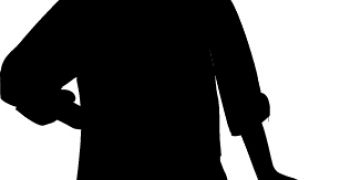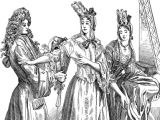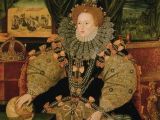While in a previous article we spoke of some of the most popular killer fashion trends throughout time, this is just the moment to bring to the table the three deadliest such trends, statistically speaking. Last time, we spoke about the crinoline, the corset and footbinding as having been popular dangerous styles – this time, it’s the turn of the fontange, the lead makeup and the stiff dandy collar, also thanks to the guys over at Cracked.
To start things off, the fontange was more than just the wig women of the days of yore used to wear. It was also referred to as headdress, since it implied several pieces of cloth (lace and ribbons mostly), and other adornments interwoven with natural hair. By the 17th century, the fontange had reached such impressive dimensions that it was actually harboring entire ecosystems. However, this was the least of women’s concerns at the time, since the fontange also made it very likely for them to catch their death by fire.
As a matter of fact, this is what made this headdress so dangerous. Since lighting was then made with huge candle chandeliers, women would often forget the heights the fontange could reach, and walk under said fire source carelessly. The results were, of course, that the item would catch fire, burning their face and neck in the process – since, obviously, taking it off was not an option, as it was tightly fixed to the skull using the woman’s natural hair.
Many such cases have been documented throughout the 17th and 18th century, which should also stand for the popularity of the fontange, in the sense that women kept on wearing it despite the obvious risks.
Another killer fashion trend was, this time, more related to beauty than fashion per se. We all know from history classes that, once upon a time, a beautiful woman was necessarily a pale one. If a lady had rosy cheeks or a sunkissed skin, then she was not noble, since paleness was a clear mark of distinction.
To get this pallor, women had several allies: the corset (which impeded them to breathe properly, therefore they were pale most of the time), chalk (which they would eat to get sick) and lead makeup. The last item was the most deadly of the lot, since its effects would only be felt in time and, ironically enough, required more makeup of the same kind to hide.
Lead poisoning was common both in men and women, since everybody wanted to be fashionably pale. Other than the effects that would become painfully noticeable in time (such as brain damage, headaches, loss of appetite, anemia, a constant metallic taste in the mouth, paralysis, and insomnia), this type of makeup also literally destroyed the skin on the face. Because there was no other type of cosmetic product to use to hide damaged skin, people would apply more of the same, until they met their end from it. Marie Gunning, an Irish noblewoman whose beauty and fair skin had made her famous, became the first documented victim of cosmetic lead poisoning in 1760.
The last deadly fashion item on the list is, this time, a men’s exclusive. Popular in the 19th century, it was a true dandy’s must-have, and caused many deaths just because it was the most fashionable thing to have. The high, stiff collar was a detachable collar that the likes of Oscar Wilde made famous – it was dangerous because it was so starched that, legend has it, even bullets could not penetrate it. Being not only stiff, but also high, it could kill a less careful wearer by strangulation or, it is said, by severing the neck much in the manner of a guillotine, as a man in the 1800s was about to find out as he tripped while dismounting from a street car.
Then again, the high stiff collar could also act silently by cutting off circulation to the brain. It is said that many men died this way, on nights when they had one too many drinks and did not realize that what they were feeling was not the effect of alcohol but that of the lack of blood to the brain. As a matter of fact, the risks that came with this fashionable dandy piece were somewhat known – in several European languages, it was called “father killer” (Vatermörder), but that did not stop men from wearing it. It is believed that most associated the erectness of the collar with their manhood.
So, this was all for our short recap of the six most deadly fashion trends throughout time. If you enjoyed our trip, do come back for more.

 14 DAY TRIAL //
14 DAY TRIAL // 


